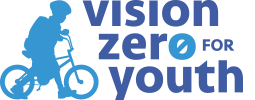Prioritizing safe school zones to safeguard every child’s journey to school in Pleiku City and the greater Gia Lai Province, Vietnam
Winner of the 2022 Vision Zero for Youth International Leadership Award! View the press release.
Download this Success Story as a PDF.

Photo source: AIP Foundation.
Cities across the world are working to improve road safety by reducing speeds, especially around schools. Pleiku City and the greater Gia Lai Province in Vietnam, through a combination of various interventions – including improvement of school zone infrastructure, education, communications, and policy advocacy, have made landmark advances to save lives notably by reducing speeds in school zones. Pleiku City now serves as a model for safe school zones nationwide. The Slow Zones, Safe Zones program implemented in partnership with AIP Foundation – a regional organization dedicated to reducing road crash injuries and fatalities in low-and middle-income countries – started with two schools and expanded throughout Pleiku City. The program eventually reached 31 primary schools in the city. Through partnerships at the local, provincial, and national levels, the program’s reach is extending to the entire country.
For the impressive work of the city and provincial government to improve road safety for youth, Pleiku City and the Gia Lai Province in Vietnam are the recipients of the 2022 Vision Zero for Youth Leadership Award. Led by the National Center for Safe Routes to School with support from the FIA Foundation, the International Vision Zero for Youth Leadership Award recognizes noteworthy road safety practices that can inspire other cities to take bold steps to reach zero traffic deaths among children and youth in their communities.
Commitment to speed reduction: starting small and building on success
Pleiku City is the capital of the Gia Lai Province in Vietnam. The collaboration with various governmental partners, such as the National Traffic Safety Committee (NTSC), the Ministry of Education and Training, the Ministry of Transport, the Gia Lai Provincial People’s Committee, the Gia Lai Provincial Traffic Safety Committee, and related departments of Gia Lai Province, has led to the renovation of infrastructure around school zones and a reduction in speeds in school zones to 30-40 kilometers per hour (km/h), a milestone in speed reduction regulation in Vietnam through the Slow Zones, Safe Zones program.
The Slow Zones, Safe Zones program – launched in 2018 – uses a multi-pronged approach that includes the construction of tailored school-zone modifications, public awareness campaigns, law enforcement initiatives, legislative advocacy, and the development of a Traffic Safety E-curriculum. This program, which aims to reduce injuries and fatalities on school roads, is supported by Fondation Botnar, the Global Road Safety Partnership (GRSP), the FIA (Fédération Internationale de l’Automobile), and the International Road Assessment Programme (iRAP), and aligns with the Global Plan of the Decade of Action for Road Safety 2021-2030.
The first phase of the initiative began with two schools in 2018. Pre-intervention assessments showed roads near these schools scored 3 stars or below on the iRAP Star Rating for Schools (SR4S). Star Rating for Schools is an objective measure of the level of safety with 1-Star roads having the highest risk and 5-Star roads having the lowest risk. After the infrastructure intervention, both pilot schools successfully increased their road safety rating to 5.
The program also incorporated speed enforcement initiatives and speed reduction regulations during school rush hours. Before the pilot program, vehicle speeds were measured as high as 70-80 km/h at target schools—significantly exceeding the internationally recommended speed of 30 km/h in school zones. After the interventions, maximum speeds at both target schools were reduced by as much as 18-21 km/h. Among self-reported student-involved road crashes, the rate of crashes near target schools decreased from 34.1% to 30.4%. In addition, 86.1% of surveyed drivers reported having driven slower when passing target school zones.
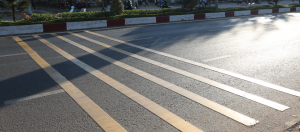
Photo source: www.aip-foundation.org
On October 15, 2019, the Circular 31/2019 officially took effect in Vietnam requiring that the “installation of speed signs must be based on the actual situation of the road sections and routes on traffic infrastructure, on the flow, types of vehicles and the time of day”. Before, Vietnam operated under a fixed speed limit, meaning that factors such as time of day, traffic flow, road, and weather conditions, were not considered, leading to reduced traffic efficiency, inhibited drivers, and increased unsafe conditions that cause traffic accidents. Now, speed signs should be based on the actual situation of that road, allowing local government agencies to designate reduced speed for their schools during peak hours.
In 2020, based on the Slow Zones, Safe Zones program results and thanks to the new Circular 31/2019, the Gia Lai provincial government issued a Legal Document, lowering speed around school zones and calling for Pleiku City to allocate funds from the city’s budget to install road modifications in school zones. The provincial government mandated that Pleiku City authorities install speed limit signs and enforce limits during peak school arrival and departure hours on school roads with speeds not exceeding 30 km/h on city roads or 40km/h on national roads. The Legal Document represents a landmark step towards defining and securing safer school zones throughout Vietnam, demonstrating the government’s heightened commitment to protecting children on the roads and the growing potential for Pleiku City to serve as a model city for safe school zones nationwide.
Based on experiences gained from the Slow Zones, Safe Zones program, AIP Foundation continued working with Gia Lai Provincial Traffic Safety Committee and other relevant stakeholders to cover the remaining 29 primary schools in Pleiku City. The Star Rating for Schools (SR4S) technique was applied to assess the safety level in school zones, in addition to road safety certified audits being conducted for all schools. Results of SR4S assessments and the audits report were used for modification designs, together with strong technical inputs from local government partners and GRSP, supported by efforts in collecting community feedback.
School modifications at primary schools in Pleiku City included:
- Renovating, expanding, building 804,080 square meters of asphalt concrete road surface and cement concrete;
- Construction of 2,080 square meters of pavement, entrance and cement concrete yard;
- Installing 136 road signs (including school zone, parking area for parents and children, speed limit, slow down, stop, intersection, etc.);
- Painting 735.88 square meters of road lines;
- Installing 49 clusters of rumble strips;
- Installing 19 pedestrian crossings;
- Installing 146.17 meters of railing to separate walkways and parking areas;
- Installing 14 sets of solar-powered yellow flashing lights.
The school zone modifications were completed at a total of 31 program schools in December 2021. In addition, school zone speed limits of 30 km/h and 40km/h were implemented during arrival and dismissal times.
Road safety education: Traffic Safety E-curriculum for all primary students
To progress toward national adoption of a road safety e-curriculum, a Traffic Safety E-curriculum was piloted with students from geographically diverse regions, including the cities of Pleiku (Central Highlands), Thai Nguyen (North), and My Tho (South). As a part of the pilot, four teacher training sessions were held to introduce the E-curriculum content and usage to more than 180 teachers.
The introduction of the E-curriculum to teachers served as a key capacity-building opportunity for school administrators and educators to integrate technology into classrooms in Gia Lai Province – a region with a high ratio of low-income households (17%), of which 82% come from ethnic minority groups with limited access to education.
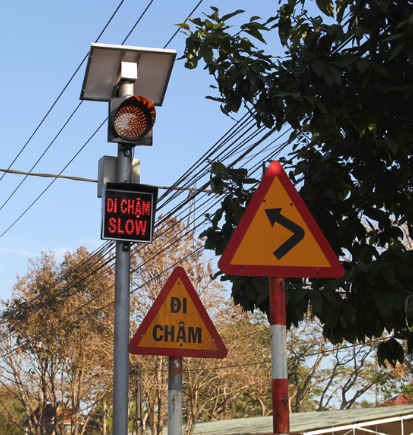
Photo source: www.aip-foundation.org
The E-curriculum provides an effective and creative student-centered educational tool for primary students to learn essential traffic safety skills from a young age. The E-curriculum considers the variety of commuting options in Vietnam with seven main transportation modes included, from cycling to boat travel, as well as knowledge and skills including safe journeys to school, road traffic signs, road crash consequences, and avoiding road crashes.
Provided through an online platform, it can be taught in class by teachers – as part of the fundamental knowledge provided by the school – but also accessed by every child from home to learn independently how to behave safely on the road. The course features interactive videos, games, and activities designed to teach students life-saving skills related to safer road behaviors.
Following the teachers’ training, the Traffic Safety E-curriculum was piloted with 1,485 students at four schools in Pleiku, My Tho, and Thai Nguyen cities. Impacts of the road safety curriculum and awareness-raising efforts in primary schools included students indicating a greater sense of safety to walk to school, as opposed to relying on private vehicles and their parents to commute to school.
In a post-evaluation assessment, there was a 13-67% increase in students across grades 1-5 demonstrating good knowledge of road safety practices – a major milestone in increasing access to education, especially for low-income households where transport to school is a barrier for parents who are unable to commute with their children to school during regular pick-up and drop-off hours. The pilot study also helped to gather key insights into how to integrate the E-curriculum into Vietnam’s national education system.
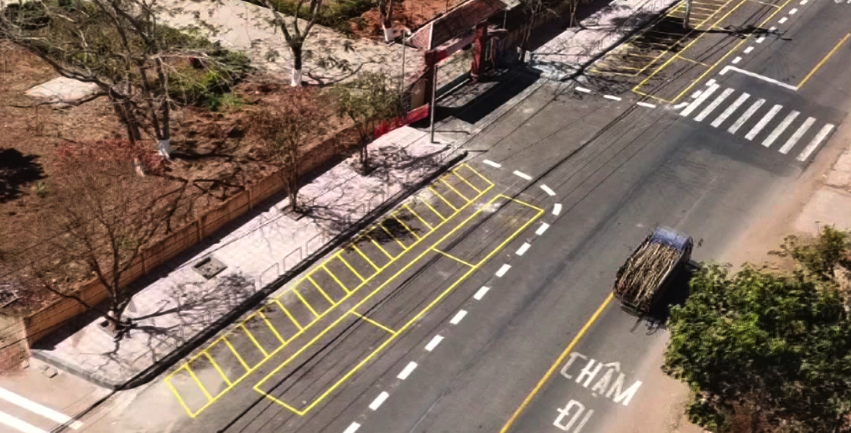
Photo source: www.aip-foundation.org
From a local program to international recognition
In May 2022, the following successful milestones of the Slow Zones, Safe Zones program were celebrated during the closing event of the second phase of the program held in Pleiku:
- Assessment of Star Rating for Schools (SR4S) results, with all 25 surveyed schools were upgraded to 3 stars and above. 21 schools out of 25 schools were upgraded to 5 stars – the highest-ranking regarding safety with SR4S.
- Approval of the first School Zone Definition by the Pleiku’s People’s Committee on May 16 through the legal document 1566/UBND-QLDT. This School Zone Definition will apply to new schools and existing schools undergoing modifications in the city, providing better protection for students commuting to and from school.
- The first Traffic Safety E-curriculum was approved – Ministry of Education and Training signed Decision No 946 /QD-BGDĐT – to be used as an official school material for integrated teaching and activities on traffic safety education in the primary school system nationwide.
In addition, national and local governments have been awarded with:
- The Prince Michael International Road Traffic Safety Award 2020 to the National Traffic Safety Committee (NTSC) and the Ministry of Education and Training (MOET). This award is the recognition of the organizations’ great contribution to the improvement of road safety around the world. Though initially awarded in November 2021, due to the pandemic, the annual ceremony did not take place.
- The International Vision Zero for Youth Leadership Award 2022 to the Gia Lai Province People’s Committee and Pleiku City People’s Committee. This award recognizes noteworthy road safety practices that can inspire other cities to take bold steps to reach zero traffic deaths among children and youth in their communities.
Reaching all school zones in Vietnam
In 2022, the Ministry of Transport and AIP Foundation signed the Partnership Framework for the Safe School Zones Guide (SSZ Guide) 2021 -2025 to safeguard every child on their journey to and from school in Vietnam.
The SSZ Guide builds upon the successes achieved in Pleiku City and will be used to implement infrastructure modifications at 13 schools in Northern, Central, and Southern Vietnam. The aim of the 4-year program is to apply mandatory engineering parameters for all school zones in Vietnam including 30km/h speed limits. All newly built schools will be designed with these parameters in mind and all existing schools will be gradually upgraded as well.
This initiative is being scaled up throughout Vietnam and fits with Vietnamese targets to improve infrastructure in its 2021-2030 National Strategy, including 100% of new national highways and provincial roads and 75% of the total length of the national highway network are 3 stars or more, according to the iRAP star rating system. New, upgraded, and renovated roads include dedicated lanes for motorcycles, motorbikes, and bicycles, and ensure safety for vulnerable road users; and 100% of school gate areas located on national highways, provincial roads, and urban main roads receive road safety improvements and congestion prevention.
The E-curriculum provides an effective and creative student-centered educational tool for primary students to learn the essential traffic safety skills from a young age. It has been approved by the Ministry of Education. This is the first nationwide-applied traffic safety E-curriculum for primary students in Vietnam.
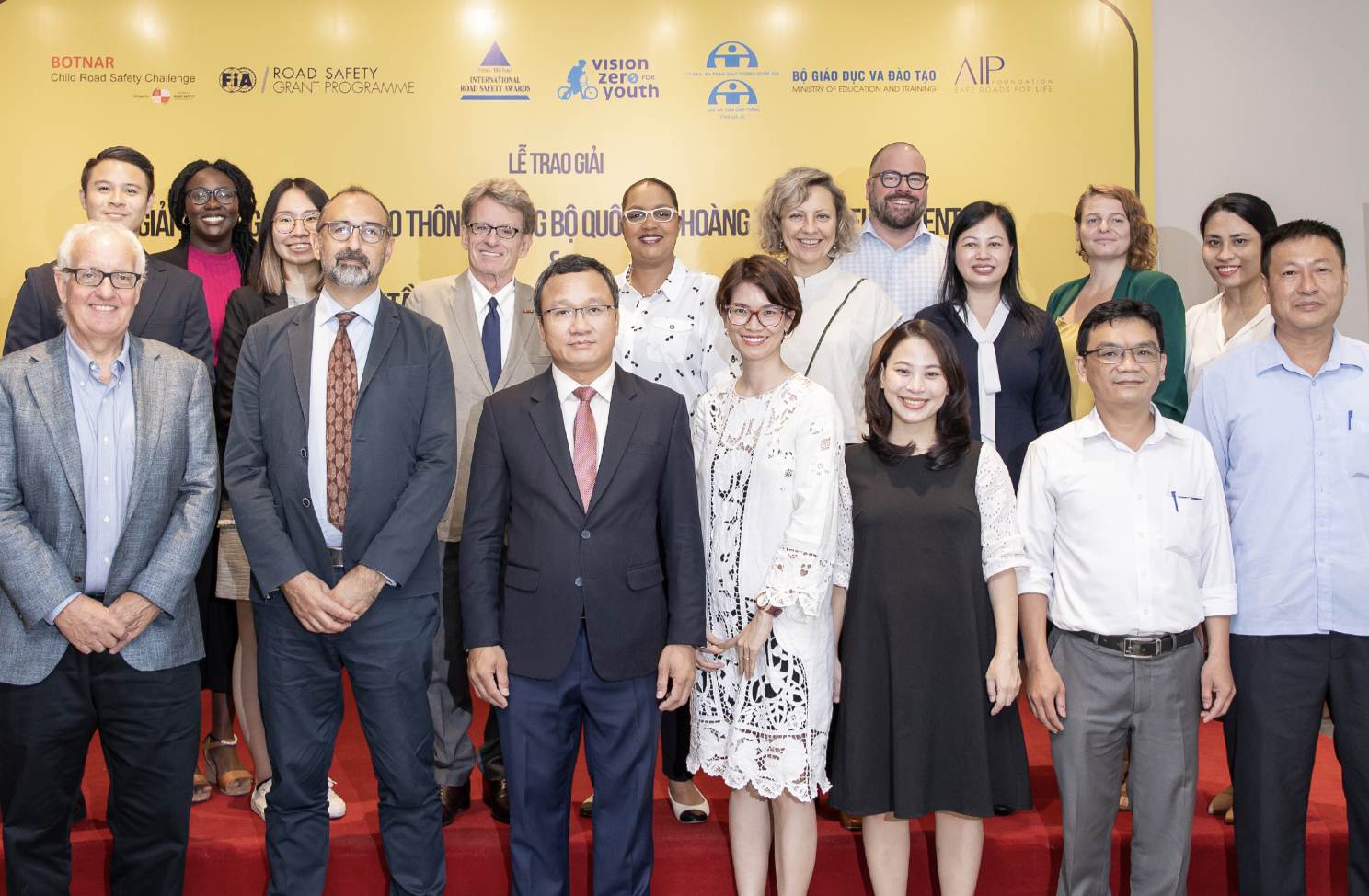
Attendees and awardees gathered at the Press Club Hanoi for the Vision Zero for Youth Leadership Award ceremony on September 21, 2022.
Photo source: AIP Foundation.
Political leadership and partnerships at the national and provincial levels
The ability of local and national governments to work together on behalf of Vietnam’s children, in collaboration with AIP Foundation, is key to the growth of these life-saving initiatives. Key national political leaders include Vietnam’s National Traffic Safety Committee and the Ministry of Education and Training. At the provincial level, local government agencies include the Gia Lai People’s Committee, the Gia Lai Traffic Safety Committee, the Gia Lai Department of Education and Training, local traffic police and the Pleiku People’s Committee. The Gia Lai People’s Committee was the agency responsible for passing a Legal Document to reduce speed in school zones in Pleiku City.
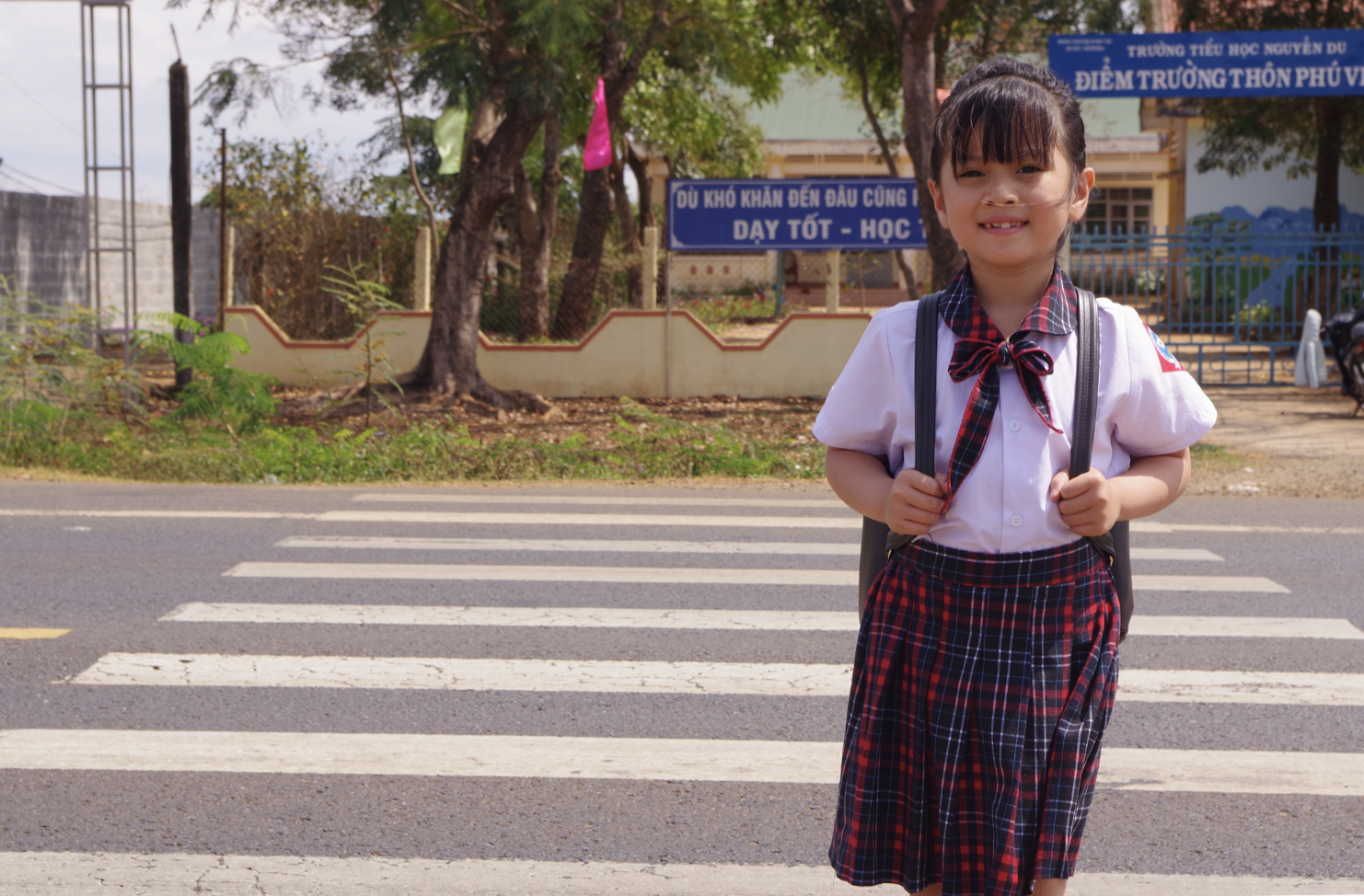
Student walking in a crosswalk improved by the Slow Zones, Safe Zones program in Gia Lai Province.
Photo source: AIP Foundation.
Replicability
The program started with two schools and eventually reached 31 primary schools in Pleiku City. From May to September 2022, Pleiku Government completed the school modifications for one primary school and three secondary schools in Pleiku City. In addition, they plan to upgrade the other 56 schools located on the provincial roads. These improvements are all funded by the Gia Lai Provincial Government.
Through partnerships at the local, provincial, and national levels, the program’s reach is extending to the entire country. The work that started in Pleiku City is a model that can be replicated both in national and global contexts. Key elements include using evidence-based systems for data collection (such as the iRAP Star Ratings for Schools app), developing local capacity in applying these technologies, improving infrastructures and school zone environment, forming partnerships across the public and private sector, launching awareness campaigns designed to mobilize the public, and demonstrating the proven value of investing in road safety to governments.
